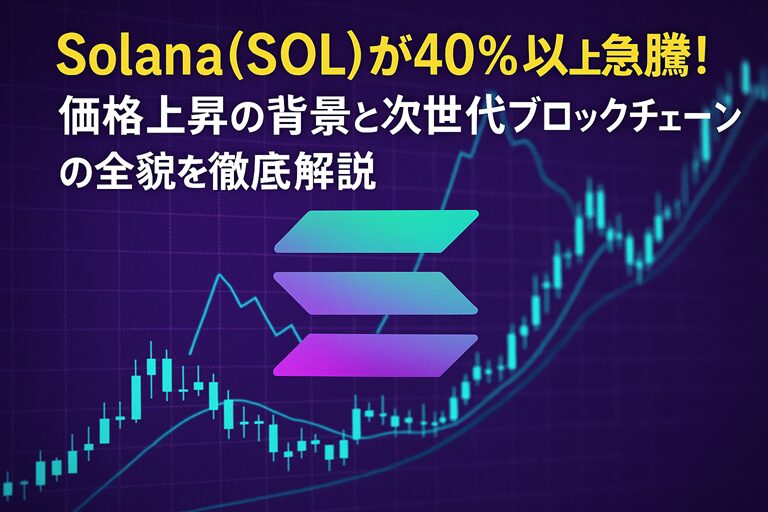目次
- 1 Solana (SOL) Surges 40%: Price Analysis & Future Outlook
- 1.1 1. Three Main Factors Behind SOL’s Price Surge
- 1.2 2. What is Solana (SOL) – Understanding the Basics
- 1.3 3. Innovative Technology Behind Solana – The Secret to High Speed and Low Cost
- 1.4 4. SOL Tokenomics and Incentives for Holders
- 1.5 5. The Rapidly Growing Solana Ecosystem
- 1.6 6. Developer Ecosystem and Community Power
- 1.7 7. Solana’s Historical Background – Recovery from FTX Collapse
- 1.8 8. Solana’s Challenges and Solutions
- 1.9 9. Future Outlook and Expected Technological Innovations
- 1.10 10. SOL Price Predictions and Investment Considerations
- 1.11 11. How to Buy and Manage SOL
- 1.12 12. Summary – Solana’s Potential and Considerations
Solana (SOL) Surges 40%: Price Analysis & Future Outlook
Current SOL Price (Real-time)
Market Cap: $98.8B | Rank: #6
※As of July 25, 2025
Recently, Solana (SOL) has shown an impressive surge of over 40% in the cryptocurrency market, becoming a hot topic on social media platforms including X (formerly Twitter). As of July 2025, SOL has recorded an increase of over 200% year-to-date, showing momentum to break through the $200 level.
This article provides a comprehensive analysis of the background behind Solana’s price surge, its innovative technical mechanisms, diverse ecosystem, and future prospects for those interested in cryptocurrencies.
1. Three Main Factors Behind SOL’s Price Surge
Solana’s price surge has clear reasons. Analyzing the movements since the beginning of 2025, we can identify three main factors driving the price increase.
1.1 CME Group’s Planned Launch of SOL Futures
In February 2025, news that CME Group, the world’s largest futures exchange, plans to launch Solana (SOL) futures became the biggest factor in the price surge. Listing on CME means opening official channels for institutional investors to invest in SOL, creating a significant market impact.
1.2 Full-Scale Entry of Institutional Investors
Large-scale purchases of SOL tokens by DeFi Development Corp and investments by corporations like BIT Mining have occurred in succession. Furthermore, major asset management companies like BlackRock and ARK Invest have shown interest in the SOL market, stimulating retail investors’ buying appetite.
1.3 Increased On-Chain Activity and Surge in DEX Trading Volume
Notably, Solana’s weekly DEX (decentralized exchange) trading volume has surpassed Ethereum. This is an important indicator showing that actual users are actively using the Solana network, proving this is not merely speculative price appreciation. In early 2025, meme coin trading accounted for approximately 70% of Solana network traffic.
2. What is Solana (SOL) – Understanding the Basics
2.1 Birth and Background of Solana
Solana was developed by Solana Labs starting in 2017, led by former Qualcomm engineer Anatoly Yakovenko, with the mainnet beta officially launching in March 2020. Aiming to solve the scalability issues (processing speed and fees) of traditional blockchains, it has gained attention as an “Ethereum killer.”
2.2 Role of Native Token SOL
In the Solana network, SOL functions as the native token. SOL is primarily used for the following purposes:
- Transaction fee payments
- Network staking: By staking SOL, users contribute to network security and earn rewards
- Governance participation: SOL holders can participate in governance voting that influences decisions about Solana’s future, such as protocol updates
SOL is divisible into the smallest unit called “Lamport,” with 1 SOL = 1,000,000,000 Lamports.
2.3 Market Position
As of July 2025, SOL’s market capitalization exceeds approximately $98.8 billion, ranking 5th-6th in the cryptocurrency market.
3. Innovative Technology Behind Solana – The Secret to High Speed and Low Cost
3.1 Proof of History (PoH)
Solana’s biggest feature is its unique consensus algorithm called Proof of History (PoH). PoH provides a “proof of time” that assigns accurate timestamps to each transaction and cryptographically proves the sequence of events. This eliminates the need for nodes (network participants) to synchronize with each other (asynchronous consensus), enabling high-speed transaction processing.
3.2 Tower BFT and Delegated Proof of Stake
Solana adopts the following mechanisms in parallel with PoH:
- Tower BFT: A consensus algorithm redesigned by Solana that works in conjunction with PoH. It improves network security by prohibiting double voting and strictly controlling voting procedures for subsequent blocks
- Delegated Proof of Stake (DPoS): Introduces a voting mechanism designed to prevent validators from having excessive influence over the system
3.3 Overwhelming Processing Capacity and Low Fees
These technologies enable Solana to achieve the following performance:
| Metric | Solana | Bitcoin | Ethereum |
|---|---|---|---|
| Processing Speed (TPS) | Up to 65,000+/sec | ~6/sec | ~15-30/sec |
| Average Fee | ~$0.00025 | $1-50 | $5-100 |
| Block Time | 400 milliseconds | 10 minutes | 12-14 seconds |
3.4 Other Technical Features
- Sealevel: Parallel smart contract execution environment. Fully utilizes multi-core CPUs to process multiple transactions simultaneously
- Turbine: Protocol that streamlines data propagation
- Gulf Stream: Accelerates transaction caching and forwarding
- Cloudbreak: Technology that streamlines data management
- Single-layer approach: Unlike Ethereum which relies on Layer 2, completes all transaction processing in a single layer
4. SOL Tokenomics and Incentives for Holders
4.1 Staking and Rewards
SOL holders can stake SOL to contribute to network security and earn rewards.
Current Staking Information
- Reward Rate: Approximately 7%-8.26% annually
- Total Staked: About 70% of circulating supply
- Number of Validators: Approximately 3,400 nodes
Liquid Staking (LST)
- JitoSOL (JTO): Liquid staking protocol with the highest TVL (Total Value Locked) on Solana. Also earns MEV (Maximal Extractable Value) rewards
- Marinade Finance (MNDE): SOL token liquid staking protocol that maintains liquidity while staking
4.2 Inflation Strategy and Burn Mechanism
Tokenomics Mechanism
- Inflation Strategy: Starting from 8% initial inflation rate, decreasing by 15% annually, eventually stabilizing at 1.5%
- Burn Mechanism: 50% of transaction fees are automatically burned
- Current Inflation Rate: Approximately 5.5% (as of 2025)
5. The Rapidly Growing Solana Ecosystem
5.1 DeFi (Decentralized Finance)
Solana is growing as an ideal platform for DeFi applications due to its high speed and low cost characteristics.
Major Decentralized Exchanges (DEX)
- Jupiter: Liquidity aggregator that finds optimal price routes
- Raydium: Functions as an automated market maker (AMM)
- Orca: DEX with user-friendly interface
Lending Protocols
- Save (formerly Solend): Provided full compensation after the November 2022 oracle attack and adopted PYTH oracle
- Kamino: Provides automated liquidity management
5.2 NFT (Non-Fungible Tokens)
Solana is attractive for NFT minting and trading due to minimal gas fees and network congestion issues.
| Category | Projects/Platforms |
|---|---|
| Popular Projects | DeGods, Okay Bears, Mad Lads |
| Marketplaces | Magic Eden, Solanart, Honeyland, SolSea |
| Innovative Technology | xNFTs (Backpack wallet compatible) |
5.3 GameFi (Blockchain Gaming)
- Star Atlas: Space-themed MMORPG
- Aurory: Pokemon-style RPG game
- SOL Survivor: Fighting game
- Fantasy Sports: Sports fantasy games
5.4 Meme Coins
The Center of the Meme Coin Boom
From late 2023 to 2025, Solana established its position as the main platform for meme coins. In early 2025, meme coin trading grew to account for approximately 70% of Solana network traffic.
- Popular Tokens: BONK, DOGWIFHAT
- Pump.fun: Representative meme coin issuance platform
5.5 Enterprise Partnerships and Practical Applications
| Company | Partnership Details | Impact |
|---|---|---|
| Visa | USDC cross-border payment pilot | Streamlining international transfers |
| Shopify | Solana Pay integration | E-commerce payment innovation |
| Google Cloud | Validator participation, BigQuery data provision | Infrastructure enhancement |
| AWS | Solana blockchain support | Development environment improvement |
5.6 Web3 Smartphones and Other Initiatives
- Saga: Web3 smartphone launched in 2023
- Seeker: Successor model planned for 2025
- Franck Muller: Announced limited edition luxury watch themed on SOL
6. Developer Ecosystem and Community Power
6.1 Developer Growth and Opportunities
Developer Ecosystem Growth
- Job Postings: Increased from 15 in January 2023 to 95 currently
- Hackathon Projects: Over 3,000 in the past 3 years
- Total Funding Raised: Over $600 million
- Recent Hackathon Applications: Over 900
6.2 Global Communities
- SuperteamDAO: Focused on India, now has chapters in 8 countries
- Superteam Japan: Landed in Japan in May 2024
- Gen3 (Taiwan), MetacampDAO (Singapore), mtnDAO (USA)
6.3 Developer Tools and Resources
| Category | Tools/Resources |
|---|---|
| Programming Languages | Rust, C, C++, Solidity (via Neon EVM) |
| Frameworks | Anchor, Solang |
| Documentation | Solana Cookbook (hundreds of code snippets) |
| Development Environment | Solana Tool Suite, Neon EVM |
7. Solana’s Historical Background – Recovery from FTX Collapse
7.1 Founding Period and Fundraising
Anatoly Yakovenko realized that Ethereum could not support large-scale on-chain transactions and began developing a faster blockchain. In June 2021, they raised approximately $314 million from investors including Andreessen Horowitz and Polychain Capital.
7.2 Relationship with FTX and Rapid Growth
The support of FTX founder Sam Bankman-Fried (SBF) greatly contributed to Solana’s rise. SBF highly valued Solana’s performance and exerted significant influence. This led SOL token to reach its 2021 peak of $248.
7.3 “Crypto Winter” and Impact of FTX Collapse
2022 Challenges: The “crypto winter” and FTX collapse severely impacted the entire Solana ecosystem, with SOL price temporarily falling below $10.
7.4 Revival and Recovery
However, Solana overcame the period when it was seen as having “no chance of recovery” and chose a practical path to revival.
- Demonstrated financial transparency
- Significantly optimized network infrastructure
- Effectively reduced downtime occurrences
- Strengthened hackathon activities
- Activated developer community
8. Solana’s Challenges and Solutions
8.1 Network Stability
Solana has experienced multiple network outages (downtime) in the past. A major outage lasting approximately 5 hours occurred on February 6, 2024.
Causes include:
- Transaction surges
- Bug occurrences
- Massive requests from bots
- Enormous transaction volume from arbitrage and NFT mint bots
8.2 Decentralization Challenges
| Challenge | Details | Countermeasures |
|---|---|---|
| High Hardware Requirements | Validators need high-performance equipment | Ongoing requirement optimization |
| Stake Concentration | Top 30 validators hold over 35% | Reviewing decentralization incentives |
| Node Operating Costs | Thousands of dollars monthly | Considering efficiency improvements |
8.3 Regulatory Risks
The U.S. Securities and Exchange Commission (SEC) has suggested the possibility of considering SOL as an “unregistered security,” and regulatory changes remain an uncertain factor affecting price and adoption. Approval of SOL spot ETF is noted to potentially depend on changes in SEC leadership.
8.4 Tokenomics and Inflation
SOL has no supply cap, and if demand doesn’t keep up with supply increases, SOL value could decrease. However, a deflationary mechanism where 50% of transaction fees are burned is also built in.
9. Future Outlook and Expected Technological Innovations
9.1 Firedancer – Game-Changing Technology
The new validator client “Firedancer” being developed by Solana Foundation and Jump Crypto:
- Achieves approximately 2x current processing capacity
- Aims for 1 million TPS in the future
- Full deployment scheduled for 2025
9.2 Other Technological Innovations
- SuperSol: Solana’s first native L2 “Evanescent Rollups” to overcome scalability challenges
- QUIC: Network upgrade
- Stake-weighted Quality of Service (QoS)
- Local fee markets
- Token Extensions: New standard that unlocks complex business logic
- ZK Compression: On-chain state compression
- Blinks: Transaction functionality on web pages
9.3 Expansion into New Areas
- DePIN (Decentralized Physical Infrastructure)
- AI integration areas
- Strengthening enterprise partnerships
10. SOL Price Predictions and Investment Considerations
10.1 Analyst Price Predictions
| Period | Conservative | Neutral | Optimistic |
|---|---|---|---|
| End of 2025 | $90-260 | $200-220 | $230-550 |
| 2028 | $300-400 | $500+ | $800-1,000 |
| 2030 | $500-800 | $1,000+ | Up to $2,200 |
10.2 Technical Analysis Perspective
Important Technical Indicators
- Cup and Handle Pattern formation: Precursor to long-term uptrend
- Golden Cross (end of June 2025): Strong signal for medium to long-term uptrend
- Support Line: Strong support around $150-160
- Resistance Line: Next target around $250-300
10.3 Institutional Investor Trends
- Expectations for SOL Staking ETF
- SOL Spot ETF applications (already listed in Canada, futures trading started in Brazil)
- CME Group SOL futures launch (scheduled for February 2025)
11. How to Buy and Manage SOL
11.1 Purchasing on Domestic Exchanges
Exchanges Where You Can Buy Directly with Fiat
- SBI VC Trade
- bitbank
- GMO Coin
- Coincheck
- CoinTrade
※Exchange format has narrower spreads (fee differences) and can reduce costs.
11.2 Using International Exchanges
For more tokens and advanced trading features:
- Binance
- Bybit
- OKX
- MEXC
- Kraken
- Coinbase
11.3 Wallet Selection
| Wallet | Features | Rating |
|---|---|---|
| Phantom | Popular Solana-specific wallet | ★★★★★ |
| Solflare | User-friendly UI | ★★★★☆ |
| Backpack | xNFTs compatible | ★★★★☆ |
| Ledger | Hardware wallet, highest security | ★★★★★ |
11.4 Management Methods
Management Options
- Staking: Annual rewards of approximately 7%-8.26%
- Dollar-cost averaging: GMO Coin’s “Crypto Accumulation” etc.
- Lending: High annual yields on platforms like Nexo
- DeFi operations: Liquidity provision and lending (beware of risks)
12. Summary – Solana’s Potential and Considerations
Solana (SOL) has established a unique position in the blockchain industry through its overwhelming high-speed processing capability, low costs, and innovative technical mechanisms (PoH, Sealevel, Tower BFT, etc.), holding potential as the “next-generation blockchain” and “Web3 OS.”
Solana’s Strengths
- Processing capacity of up to 65,000+ transactions per second
- Extremely low fees averaging $0.00025
- Diverse ecosystem including DeFi, NFT, GameFi, meme coins
- Partnerships with major companies (Visa, Shopify, Google Cloud)
- Active developer community
- Full-scale entry of institutional investors
Challenges to Note: History of past network outages, concerns about centralization, regulatory risks, price volatility
Recommendations for SOL Holders
- Continuous Information Gathering: Follow the latest information through official blogs, news, and community chats
- Thorough Risk Management: Invest with surplus funds, diversify investments, implement wallet security measures
- Consider Management Methods: Choose from staking, dollar-cost averaging, DeFi operations based on risk tolerance
- Community Participation: Stay informed about latest developments through communities like SuperteamDAO
While Solana has achieved significant growth, cryptocurrency investments always carry risks. With its technical superiority, active ecosystem, and ability to meet market demand, it deserves attention as a project with long-term growth potential, but investment decisions should be made carefully.









Leave a Reply